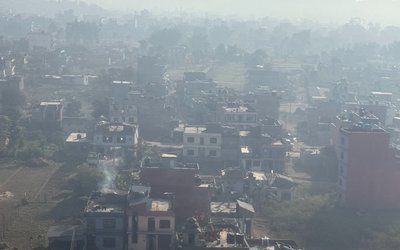In recent years, the discourse surrounding climate justice has evolved from a largely environmental concern to a multifaceted conversation that encompasses gender, social, and economic disparities. The impacts of climate change are not felt equally across communities, countries, and genders. While climate change itself is a complex and dynamically changing process, the injustices that arise as a result of it are often more tangible and deeply entrenched. From rural communities in developing countries to marginalized groups within wealthier nations, the consequences of climate change have exposed and exacerbated existing inequities, making climate justice a central issue for the global community.
At the heart of climate justice is the recognition that the vulnerable, particularly poor rural women, are often the hardest hit by climate change. Despite their limited contribution to global emissions, these communities face the greatest challenges in coping with its effects. The call for climate justice, therefore, is not just an environmental issue but a human rights issue, which demands urgent attention to social, economic, and political inequalities.
The Unequal Impacts of Climate Change
Climate change is a global phenomenon that affects everyone, but not everyone equally. The impacts of rising temperatures, increased frequency of extreme weather events, shifting rainfall patterns, and sea-level rise disproportionately affect the most vulnerable segments of society. In particular, rural poor women are facing gender-specific barriers that limit their ability to adapt to and cope with these changes. The combination of poverty, gender inequality, and limited access to resources makes them more susceptible to the adverse effects of climate change.
For instance, in rural areas where agriculture is the primary livelihood, women often carry the responsibility for food production, water collection, and household management. These tasks are becoming increasingly difficult as climate change exacerbates resource scarcity and alters agricultural patterns. Droughts, floods, and other extreme weather events not only threaten crop yields but also increase the time and labour burden on women, further deepening their vulnerability.
Furthermore, climate change is also exacerbating pre-existing social and economic inequalities. As resources become scarcer, competition for land, water, and energy increases, often leading to conflicts within communities and between countries. Wealthy nations, which are responsible for the majority of historical greenhouse gas emissions, continue to pollute at a rate far higher than developing nations, deepening global inequality. The rich have the financial means to adapt to these changes, while the poor, particularly women, are left to bear the brunt of the impact. In this way, climate change is not just an environmental issue — it is an issue of justice, equity, and human rights.
Climate Change and Gender Inequality
Gender plays a critical role in shaping how individuals experience and respond to climate change. Women, particularly those in rural and marginalized communities, often face unique challenges in coping with the effects of climate change. This is especially true in countries like Nepal, where women’s roles in agriculture, water management, and caregiving are vital to the survival of their families and communities. Yet despite their crucial contributions, women are often excluded from decision-making processes related to climate adaptation and mitigation.
In Nepal, the Climate Change Gender Action Plan (CCGAP) was developed to ensure that gender considerations are integrated into climate change policies and programs. However, despite the plan's goals, there has been limited progress in mainstreaming gender in climate adaptation and resilience efforts. The failure to prioritize gender-specific needs in climate change strategies has led to a widening gap in access to resources and opportunities for women, further entrenching their vulnerability to climate-induced disasters.
While women in rural areas are particularly disadvantaged, it is essential to recognize that the gendered impacts of climate change are not limited to developing countries. Even in developed nations, women are more likely to be affected by climate-related disasters due to social norms, economic inequalities, and lack of access to decision-making power. For instance, in the wake of natural disasters, women are more likely to face gender-based violence, displacement, and limited access to relief and recovery services. This underscores the need for a gender-responsive approach to climate justice that addresses both the root causes of inequality and the specific impacts of climate change on women.
Miniature Projects Are Not Enough
While small-scale projects have been implemented in many countries to address climate change impacts, they are often unsustainable and insufficient to tackle the underlying issues that lead to climate injustice. In Nepal, for example, numerous projects have been introduced to help communities cope with climate-induced vulnerabilities, such as the promotion of climate-resilient agriculture and disaster preparedness. However, these projects tend to be isolated, short-term, and not integrated into broader policy frameworks, making them ineffective in addressing long-term systemic inequalities.
Development projects that do not consider the social, economic, and gender dimensions of climate change are unlikely to produce meaningful or lasting impacts. The failure to mainstream gender and social justice into climate change interventions has led to situations where the most vulnerable populations continue to suffer, despite the availability of resources and knowledge. What is needed is a comprehensive approach that addresses the root causes of climate vulnerability and promotes systemic change.
Miniature, project-specific efforts have already shown their limitations. In many cases, the interventions are short-lived, lack the financial and technical resources for long-term sustainability, and fail to address the structural inequalities that fuel climate injustice. To truly achieve climate justice, it is imperative that we move beyond isolated projects and work toward comprehensive, systemic solutions that address the root causes of inequality.
Legal Frameworks and Global Cooperation
The need for strong legal frameworks at the national and international levels is paramount to achieving climate justice. In recent years, there has been growing recognition of the importance of legal action to address the injustices caused by climate change. At the international level, countries are increasingly turning to legal institutions to hold polluting nations accountable for their role in the climate crisis.
One of the most significant developments in this regard is the growing movement among small island states to seek legal clarification on the obligations of countries to take action on climate change. In early 2023, Vanuatu, a Pacific Island nation, faced two category four cyclones within 72 hours- an unprecedented event in its history. In response, Vanuatu led a group of countries in calling on the United Nations General Assembly to request an advisory opinion from the International Court of Justice (ICJ) on the legal obligations of states to act on climate change under international law. The goal of this legal action is to establish binding legal obligations for states to reduce emissions and protect vulnerable communities from the impacts of climate change.
Similarly, the Commission of Small Island States on Climate Change and International Law has asked the International Tribunal for the Law of the Sea (ITLOS) to issue an advisory opinion on the scope of state obligations to protect and preserve the marine environment. The Tribunal's 2024 advisory opinion will likely include recommendations for countries with the greatest historical responsibility for climate change to do more to reduce their emissions and mitigate the impacts of climate change on small island nations.
On the regional level, countries such as Chile and Colombia have turned to the Inter-American Court of Human Rights (IACtHR) for guidance on the legal obligations of states to address climate change within the context of regional human rights law. In 2003, Chile and Colombia requested an advisory opinion from the IACtHR clarifying what states' obligations are to respond to the climate emergency and protect human rights in the face of environmental degradation.
In Europe, the European Court of Human Rights ruled in April 2024 on a case brought by KlimaSeniorinnen Schweiz, a Swiss organization representing senior women, which argued that the Swiss government was violating its human rights obligations by failing to take sufficient action to mitigate climate change. The Court's decision represents a significant step forward in recognizing the human rights implications of climate inaction, particularly as it pertains to vulnerable groups such as women and the elderly.
These legal developments illustrate the growing momentum toward using international and regional legal mechanisms to hold governments accountable for their role in exacerbating climate change. They also demonstrate the increasing recognition of climate justice as a legal and human rights issue that requires urgent and decisive action.
The Need for Climate Justice in Nepal
Nepal, despite being one of the least developed countries, is rich in biodiversity and natural resources. It is also eligible to participate in carbon offset programs like the Reducing Emissions through Deforestation and Forest Degradation (REDD) initiative, which allows developing countries to sell carbon credits to developed nations looking to offset their emissions. Nepal has signed a multi-million-dollar agreement with the World Bank's Forest Carbon Partnership Facility (FCPF) to reduce emissions through forest conservation. However, despite its eligibility for carbon trading and its participation in global climate finance initiatives, Nepal still faces significant challenges in accessing climate finance.
The failure to effectively integrate climate finance and gender-responsive climate policies into national development plans has hindered Nepal’s ability to address climate-induced vulnerabilities. Many of the small-scale projects implemented in Nepal have not been sustainable or inclusive, and there is an urgent need for a national legal framework that prioritizes climate justice and ensures that vulnerable communities, especially women, have access to the resources they need to adapt to climate change.
As countries like Vanuatu and others in the Pacific lead the charge for global climate justice, Nepal must also take a more proactive role in addressing the injustices caused by climate change. The country should advocate for greater accountability from developed nations, push for legal reforms that promote gender equality in climate adaptation, and work to ensure that climate finance is accessible to the communities most affected by climate change.
Conclusion
The debate over climate justice is not just about the environment; it is about human rights, equity, and the fight against deep-rooted social and economic inequalities. As climate change continues to disrupt communities and exacerbate existing vulnerabilities, the need for justice has never been more urgent. The stories from Vanuatu, Chile, Colombia, and Nepal are powerful reminders that climate change is a global issue that requires collective action, legal accountability, and a commitment to ensuring that the most vulnerable are not left behind.
As the international community moves toward a future of climate action, it is essential that we put justice at the centre of our efforts. Whether through legal mechanisms, gender-responsive policies, or comprehensive development strategies, the goal of climate justice must be to reduce vulnerability, promote equity, and ensure that no one is left to bear the burden of climate change alone. The fight for climate justice is not just about saving the planet — it is about saving humanity from the worst effects of climate change and ensuring a fair and sustainable future for all.
- National Anticipatory Action Framework And Roadmap In Nepal: A Long-Awaited Leap In Nepal’s Disaster Risk Management
- Apr 15, 2025
- Localization: A Path To Socio-Economic Transformation In The Globalized World
- Mar 24, 2025
- Political Dimensions Of Localization In Humanitarian Discourse: Humanitarian Actions At Local By Regional Agencies
- Feb 11, 2025
- Sustainability In Development Projects: An Appraisal Of Nepal's Development Landscape
- Jan 19, 2025
- Saga of the Justice Reality: Work from Home with Remote Allowance
- Dec 05, 2024















